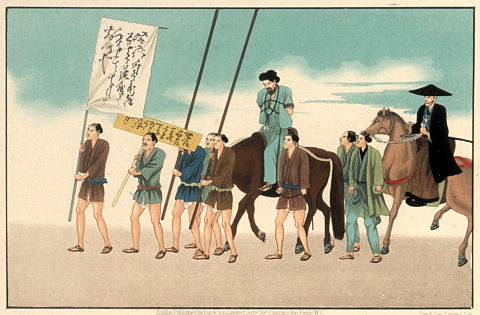The Japanese word yutanpo basically means "hot water bottle." The original referent was one of the many Chinese conveniences imported during the Muromachi period (see also kotatsu): a sealable stoneware or metal container, normally shaped something like a gourd but occasionally fancier, which was filled with hot water and placed in the bedding. Today, the meaning of yutanpo has expanded to include European-style hot water bottles as well.
What interests me about the yutanpo is the word itself. The commonly accepted kanji are 湯湯婆: "hot water" + "hot water" + "old lady". The "old lady" thing is apparently a sort of euphemism for "wife," referring to the fact that it keeps you warm in bed. (I have no reliable source for this, but it makes sense.) Pronouncing the character 湯 /tan/ is a bit unusual in Japanese; this is because it's a tō-on 唐音 or "Tang pronunciation". The more common pronunciation of 湯, tō, is the kan-on 漢音 "Han pronunciation." There are other cases where 湯 is pronounced /tan/, though, such as tanmen 湯麺 — although here, as Sugimoto Tsutomu points out in Gogenkai 語源海, the 湯 has the more historically recent meaning of "soup" rather than "hot water."
So that leaves us with the question of why 湯 "hot water" appears in this word two times, first representing a Japanese morpheme and next a Sino-Japanese one. Sugimoto's explanation, which basically tallies with other sources I checked, is that originally there was no initial yu-. The word was just tanpo (and it was written in other ways, too: 脚婆 ["leg old-lady"], 湯媼 ["hot-water old-lady-spelt-differently"], etc.) It also appears as <Tampo> in the Nippo Jisho. The yu was added in the 17th century or later, most likely because at some point it was no longer sufficiently obvious that tan meant "hot water" to enough of the people using the word. Sort of a similar process to the one in English that gives us "ATM machine" and "PIN number," or perhaps closer to "please RSVP" or (in French) "le protocole IP" [he said, reading Wikipedia].
Sugimoto suggests that the yu was added during the Meiji period, and indeed the earliest citation the 日本国語大辞典 has for 湯湯婆 is an 1885 kabuki play by Kawatake Mokuami 河竹黙阿彌 called Suitengū-megumi no Fukagawa 水天宮利生深川 ["The grace of Suitengū Shrine in Fukagawa"]:
それは此節馬喰町の平尾で売る発明の湯タンポ
That's one of those newfangled yutanpo that Hirao sell in Bakuro-chō.
And conversely you can still see plain tanpo around the turn of the 20th century, e.g. in Masaoka Shiki 正岡子規's "Kumade to chōchin" (1899)
燈炉を燃やして室は煖めてある。湯婆(たんぽ)も今取りかえたばかりだ。
The tōro [long wooden hibachi] is burning and the room is warmed up. The tanpo has just been changed.
Maybe if they hadn't been so busy coining words for "freedom" and "society" in the Meiji period, they would have had time to remember what the words they already had actually meant.
![[No-sword]](http://no-sword.jp/images/site/no-sword_banner.jpg)



